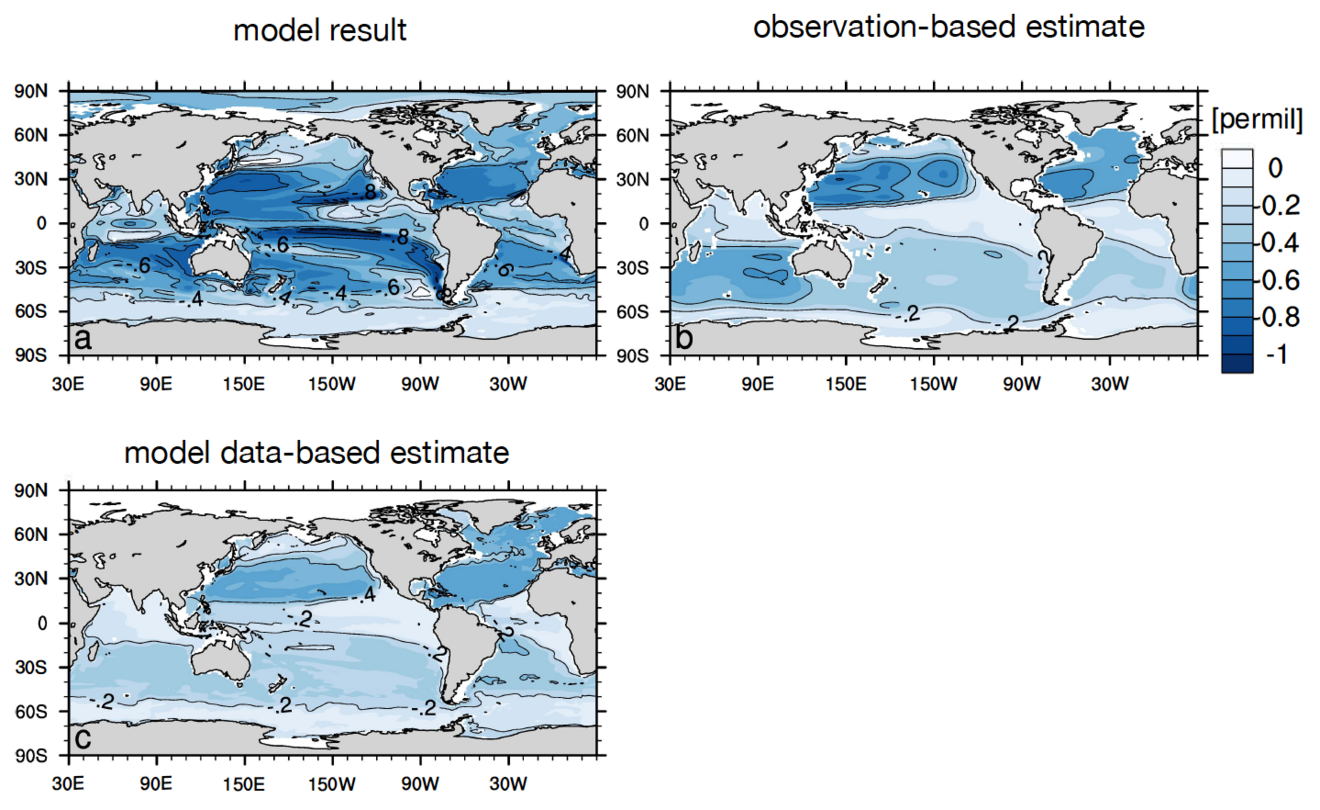Tracking the fate of anthropogenic carbon in the ocean — Modeling the global 13C-Suess effect
The 13C Suess effect is derived from the decrease of δ13C which expresses the normalised isotopic ratio of 13C/12C. Quantification of the 13C Suess effect since pre-industrial times in the global ocean, being a major sink for anthropogenic carbon, has been challenging because ship measurements only started in the late 20th century and because the oceanic δ13C decrease over the industrial period is spatially heterogeneous. The first observationally derived estimate of the global ocean 13C Suess effect was likely too low (Eide et al. 2017). The authors of that study speculated that the origin of a potential underestimation is the sparseness of the observational data, especially in regions with a strong 13C Suess effect, such as the subtropical gyres. Until now, this conjecture remained untested.
Therefore, Dr. Bo Liu, with co-authors, extended HAMOCC by adding comprehensive parameterizations of 13C accounting for changes due to biological processes and the 13C air-sea gas exchange. The good agreement between model results and observations for present-day 13C distributions and their evolution over the last century provided the ground, for the first time, to quantify the ocean 13C Suess effect by the same method as Eide et al. (2017). The authors showed that the underrepresentation of subtropical gyre waters in observational data is relevant in the Indian Ocean where it explains half of the underestimation. However, the data coverage does not explain the underestimation in the North Atlantic Ocean. The authors found two major sources of methodological underestimation: the neglect of spatial differences in preformed δ13C in 1940 (i.e., the distribution of δ13C surface concentration resulting from circulation only, in the absence of other sources/sinks in the ocean interior) and the decrease of δ13C in marine organic matter over the industrial period.
Dr. Bo Liu: “When given observationally-based data products, we often only ask whether our model is able to reproduce them. This study shows that we should also ask whether we can use the model to interpret uncertainties in observational products.”
Dr. Tatiana Ilyina: “Our analysis demonstrates the added value of comprehensive modeling to fill knowledge gaps in the functioning of the ocean carbon sink. Including carbon isotopes also opens up opportunities for direct comparison with ocean sediment δ13C measurements to evaluate the responses of ocean biogeochemistry to changes in atmospheric CO2 and climate in the past.”

Original publication
Liu, B., Six, K. D., and Ilyina, T.: Incorporating the stable carbon isotope 13C in the ocean biogeochemical component of the Max Planck Institute Earth System Model, Biogeosciences, 18, 4389–4429, https://doi.org/10.5194/bg-18-4389-2021, 2021.
Mentioned observationally-based paper
Eide, M., A. Olsen, U. S. Ninnemann, and T. Eldevik (2017), A global estimate of the full oceanic 13C Suess effect since the preindustrial, Global Biogeochem. Cycles, 31, 492–514, doi:10.1002/ 2016GB005472.
Contact
Dr. Bo Liu
Max Planck Institute for Meteorology
Email: bo.liu@mpimet.mpg.de
Dr. Katharina D. Six
Max Planck Institute for Meteorology
Email: katharina.six@mpimet.mpg.de
Dr. Tatiana Ilyina
Max Planck Institute for Meteorology
Email: tatiana.ilyina@mpimet.mpg.de
